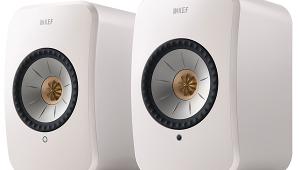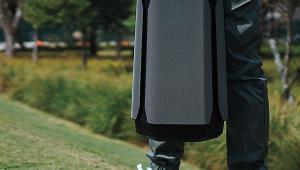Sony SRS-X9 Wireless Speaker

AT A GLANCE
Plus
Light-up touch display
Included remote
Small footprint
Minus
Accentuated highs
Lackluster mids and bass
THE VERDICT
While the small footprint is fantastic, and the bonus features exceptional, the SRS-X9’s sound quality disappointed.
How It Connects: Bluetooth, AptX, NFC, USB, LAN, DLNA, AirPlay, ⅛” analog.
Economical in the use of space, the Sony SRS-X9 measures around 17 x 5 x 5 inches and weighs about 10.5 pounds. Sony really crammed a lot into the relatively small body of the X9, with four 0.75-inch tweeters (top and front), two 2-inch midrange drivers, a 3.75-inch woofer, and two passive radiators. The overall design is your standard black side-lying monolith, though in a cool surprise, the sleek, touch-sensitive controls on top are hidden when the unit is off and only appear by backlight upon power-up. Included is a small remote control that enables you to switch input sources, adjust the volume, and play, pause, and skip songs when connecting through certain devices. The Sony SRS-X9 has tons of connection options, uniquely including Ethernet, and the ability to play through the USB port while simultaneously charging your device. There’s also Sony’s own proprietary software to “enhance” compressed audio, DSEE-HX. On paper, the X9 has everything going for it.

How Does It Sound?
As a matter of voicing, the X9 has a very treble-heavy profile. At lower volumes and focusing on folk or spoken word, this translates as higher detail, but on rock, pop, hip-hop, and jazz, the X9’s sound could be overwhelming. Cymbals and sibilants alike had a piercing, harsh quality to them, and at higher volumes, the tweeters became sizzling. Lower mids were present, but once the sound dropped into bass territory, the X9 started to lose its detail, becoming formless, and it developed some resonance issues. Granted, the X9 has a customizable EQ app that you can download for free, but despite fiddling with the settings, I never could quite find a sweet spot that highlighted the speaker’s strengths and overcame its weaknesses when playing sonically dense music.

The Bottom Line
Although it’s acceptable for spoken word and acoustic guitar at lower volumes, the X9 probably won’t please listeners accustomed to a balanced sonic profile. NPR podcast fans and treble enthusiasts might be drawn to it, but listeners with a yen for a fleshed-out bass line or rich mids can do better elsewhere, especially given all the competiton and many other excellent options at this high price point.
Specs
Passive radiator (2), 0.75 in tweeter (4), 2 in midrange driver (2), 3.75 in woofer (2); 16.9 x 5.23 x 4.9 in (WxHxD); 10.4 lb
Test Bench

This graph shows the quasi-anechoic (employing close-miking of all woofers) frequency response of the SRS-X9 Sound System (purple trace). The left channel was measured with grille at a distance of 1 meter.
The SRS-X9 Sound System’s listening-window response (a five-point average of axial and +/–15-degree horizontal and vertical responses) measures + 4.59 /– 2.71 decibels from 200 hertz to 10 kilohertz. An average of axial and +/–15-degree horizontal responses measures +5.37/–2.63 dB from 200 Hz to 10 kHz. The –3dB point is at 64 Hz, and the –6dB point is at 56 Hz.—MJP
- Log in or register to post comments






























































